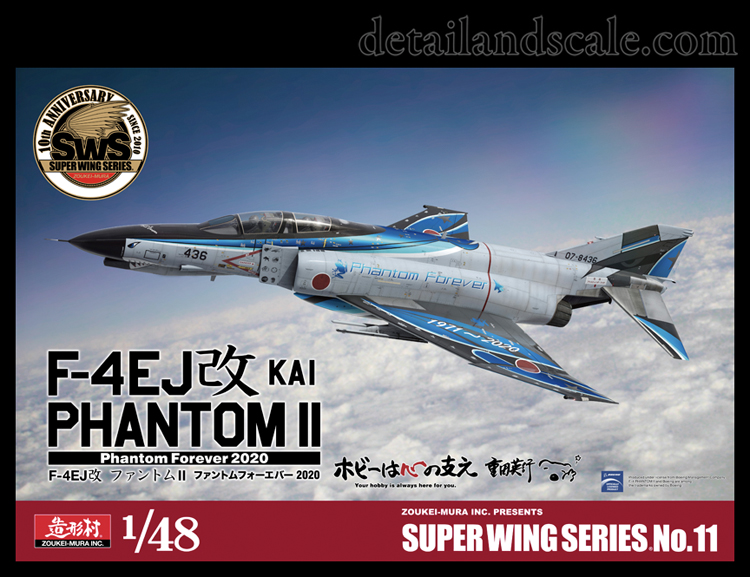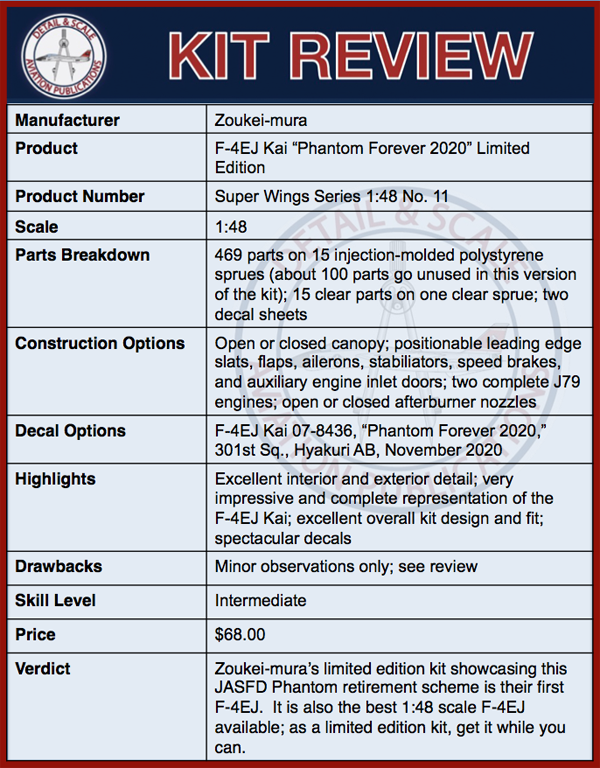Zoukei Mura Super Wings Series 1/48 #11 F-4EJ Kai “Phantom Forever 2020” Limited Edition


Several factors have aligned perfectly to bring about Zoukei-mura’s latest kit: the final flight of the F-4EJ in operational Japanese Air Self Defense Force service, their newly released 1:48 scale F-4E kit, the company’s 10th anniversary. Here, we have a pre-release review of Zoukei-mura’s limited edition F-4EJ Kai “Phantom Forever 2020” in 1:48 scale. Also, if you’re looking to acquire this kit, pre-order now, since there are already very few that still remain available preceding its impending release date.

The F-4 Phantom II was originally developed for the U. S. Navy by McDonnell Douglas in the late 1950s as a two seat, two engine, all-weather supersonic interceptor. First known as the F4H-1, it beat out the Chance Vought XF8U-3 Super Crusader to become the Navy’s principal carrier-based fighter of the 1960s. As the Vietnam War intensified, the versatility of the F-4 was demonstrated as it served in interceptor, fighter-bomber, battlefield interdiction, recce, and FAC roles with the Navy, USAF, and USMC. However, it did have some faults, and especially in the air combat arena. The absence of a gun put the F-4 at a serious disadvantage.
When it was first designed in the 1950s, McDonnell Douglas engineers and the Pentagon were overly optimistic with the promise of the guided air-to-air missile age. This doctrine then encountered reality over Vietnam. Early generation radar-guided and heat-seeking missiles were far from reliable. When long-range intercepts degenerated into close-in knife fights, cannon-armed MiGs possessed lethal advantages. The USAF’s F-4E introduced an internally mounted 20mm M61A1 gatling gun in 1965. The F-4E also included additional internal fuel, updated avionics (including a vibration-resistant AN/APQ-120 radar), leading-edge slats for increased maneuverability, and the new J79-GE-17 turbojet engines.
In 1968, the Japanese Air Self-Defense Force (JASDF) purchased 140 F-4Es, designated as the F-4EJ Phantom II. They differed from the USAF versions and lacked aerial refueling and ground attack capabilities. Mitsubishi Heavy Industries built 138 of these F-4EJs under license in Japan, with the final aircraft delivered on 21 May 1981. Later, 90 JASFD Phantoms were modernized as the F-4EJ Kai. These jets featured restored aerial refueling and ground attack capabilities, the APG-66J radar, carriage of the AN/ALQ-131 ECM pod, the addition of blade antennas on the spine, and the J/APR-6 radar warning receiver system mounted on the top of the vertical stabilizer and wingtips.
The JASDF operated the venerable F-4EJ for 48 years. The last operational squadron flying the Phantom was the 301st Hikotai (Tactical Fighter Squadron) “Samurai”. On November 20, 2020, a poignant ceremony was held at Hyakuri Air Base, 7th Air Wing, Ibaraki Prefecture. These activities marked the JASFD “phinal phlight” of their Phantoms. The 301st Hikotai prepared two special retirement or farewell schemes. The first featured F-4EJ Kai 37-8315 with yellow and black bands on the upper fuselage, and wings, accompanied by a shark mouth with the words “Go for it!! 301 Sq.” on the side of the fuselage. A second F-4EJ Kai (07-8436) had blue, cyan, white, and black bands on the upper fuselage, wings, and drop tanks. The phrase “Phantom Forever” was painted on the fuselage. “Thank you Phantom II” and “1971-2020” were painted on the upper surface of the wings. A stylized Phantom “Spook” icon was on the tail and lower wingtips. A frog “mascot” made its way into both schemes, commemorating the Japanese toad found on Mount Tsukuba near Hyakuri Air Base. Following their Phantom Sundown, the Samurais of the 301st Hikotai have now started their transition to the F-35A.

Zoukei-mura’s 1:48 scale F-4EJ Kai “Phantom Forever 2020” Limited Edition model kit comes on 15 injection molded polystyrene sprues totaling 469 parts (about 100 parts of which are not used in this variant of the kit). Fifteen clear parts come on one clear sprue. The detailed instruction booklet guides the build over 39 steps. A full-color painting and markings guide includes a very detailed stencil placement guide. Markings for one airplane is provided:
- F-4EJ Kai 07-8436, “Phantom Forever 2020,” 301st Squadron, Hyakuri AB, November 2020.
Strengths: Zoukie-mura’s 1:48 scale Phantom Phamily has been very well received over the last five years, and their 1:48 scale F-4E and EJ are very welcome additions to a subfamily of F-4Es, F-4EJs, and F-4Gs that is now in the process of rolling out.
This kit is based on the 2020 release of Zoukei-mura’s F-4E (Early) kit. It features significantly new tooling that shares little in common with their earlier F-4C and F-4D kits (and see our review of the first 1:48 scale Z-m F-4E HERE). It also has a retooled aft fuselage (the earlier F-4C/D/J/S kits didn’t quite have the full degree of curvature that it needed).
For the F-4EJ Kai, this kit contains a new set of 17 parts on Sprue P. It features the Kai’s updated front and rear cockpit displays and control consoles, the new pilot’s instrument coaming with the HUD, the distinctive ribbed radome, new wingtips and a vertical stabilizer cap, the spine blade antennas, and even a new drag chute cover with the relocated position light. To my knowledge, nothing has been overlooked here. It’s excellent. Other specific F-4EJ parts (e.g., gun muzzle, stabilator stiffeners, cockpit rear-view mirrors) are found other of the other sprues, and were not used in the USAF F-4E (Early) edition of the kit.
All the accolades that I have previously stated regarding other Zoukei-mura 1:48 scale F-4s apply to the F-4EJ kit as well. But, just too recap: the kit itself features an excellent overall accuracy and fidelity of detail. The parts are gorgeous just sitting on the sprues. The cockpit’s instrument and console details, along with other parts such as the wheel hubs, are on par with most resin detail sets. If cockpit painting is not your thing, alternate decals are provided. The Martin-Baker Mk. 7 ejection seats are also nearly perfect for an injection-molded seat (but see below). Each seat pad, backpad, and parachute pack are all separate parts. This approach allows for the most accurate and detailed seat that injection molding can produce. The shape of the ejection handles, which is sometimes quite badly done in other F-4 kits, is accurate here. There’s also a choice to build an extended stowable boarding ladder or larger external boarding ladder that hooks onto the cockpit sill.
The cockpit and nose gear well assembly are integrated, such that the floor of the cockpit and gear well roof are shared by the same part. This greatly simplifies the fit and provides precise alignment. The beautifully detailed cockpit sill, which normally is best represented with a photoetched metal detail part, is a single plastic part that drops down on top of the cockpit’s sidewalls. The two sets of clear parts allow for either open or closed canopies. The auxiliary air intake doors on the bottom of the fuselage can be positioned open.
The airframe exterior is rich with detail, such as that seen with the thousands of small perforations on the intake splitter plates (which vented boundary air overboard) and are beautifully represented. There’s also a great set of flapper doors on the back portion of the forward Sparrow missile wells.
The complete intake trunking leads to a pair of complete J79-GE (IHI)-17 engines as used in the F-4EJ Kai. They appear accurate in shape and layout but are still fairly basic. There’s a fair amount of plumbing and the prominent lever assemblies on the side of the motor are omitted. But of course, you’ll never see the J79s between from their first stage compressor blades to the afterburner nozzles in the completed model, since the engines buried inside the fuselage – except for what you can see when the auxiliary engine intake doors are open (which is anytime the F-4 is sitting on the ground). Optional open or closed afterburner nozzles are included.
Cartograf of Italy produced the decal sheet and it is beautifully made. They’ve captured that speckled metallic blue color of this paint scheme, and it’s pretty breathtaking to look at. There’s also a TON of stenciling for the airplane on its own decal sheet, impressive in its detail and thoroughness. There are even decals for the specially painted farewell flight wheel chocks. Nice touch!
Weaknesses: this is a superlative kit by any measure, but there are a few perceived shortcomings to ponder. The ejection seats lack shoulder harnesses and lap belts, but aftermarket belts are inexpensive and easy to obtain. Similarly, the plumbing in the nose gear well is pretty basic and sparse, and even one of the two really large bleed air pipes is absent. You will also want to blank off the inside of the Sparrow missile well slots. Otherwise, you’ll be able to look right into the model’s interior. The engine display stand/cradle is technically inaccurate. The instructions call it “a simplified display stand” and that’s fair enough. J79s were removed by a hydraulically powered cart and maintained on a standard wheeled cart. The stand in the kit does not represent either cart.

Zoukei-mura’s first F-4EJ kit has arrived in the form of this limited edition F-4EJ Kai commemorating the final operational flight of the Phantom II JASFD service. It is the best F-4EJ in any scale, and they nailed the variant-specific details. We look forward to their future release of F-4EJ kits starting in 2021.
If you’re hoping to acquire this kit, I suggest acting quickly. Zoukei-mura is only producing a finite number of them, and most have already been spoken for through their pre-order process, which you can find through Volks USA HERE or the Zoukei-mura site HERE. Their U. S. preorder deadline is December 13, 2020, and shipping will occur by early February 2021.
Sincere thanks are owed to Mr. Hideyuki Shigeta, the president of Zoukei-mura and their staff providing this sample. You can find out more about them at http://www.zoukeimura.co.jp/en/ and follow Mr. Shigeta’s blog at http://www.zoukeimura.co.jp/en/sentiment/oyajiblog_108.html, which is a good way to follow development of their kits and other activities of interest.
Haagen Klaus
Scale Modeling News & Reviews Editor
Detail & Scale


